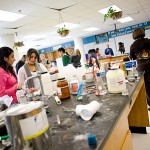Most schools today are not able to make the necessary changes they need to make to be a 21st Century school. It’s not just about technology, teaching, and learning.
Here’s what I see:
- Schools putting in wifi and maybe enough bandwidth for one device per user.
- Training teachers on the specific devices and software with a few examples for the classroom.
- A few schools going 1:1 at school. Very few school-home connections.
- Very little community and parent involvement at the school.
- Most funding for 1:1 is soft money with little available for ongoing support.
- Top down mandates and decisions about types of technology allowed.
- Firewalls and blocking software that do not give access to most Web 2.0 tools and social media.
- Focus on increasing student achievement (i.e. raising test scores).
- Lots of talk about student-centered learning with only pockets of best practices.
- Cuts in arts, physical education, counseling, libraries, and technology.
- In-flexible curriculum where students have no say in their interests or passions.
- No emphasis on the skills and values employers are looking for in their employees. See post.
- Most educational conferences still focus on testing, technology, and status quo and not on real change in the classroom. Talking about the future is sexy but teachers don’t think it’s doable in their classroom.
- Teacher education programs are subject-specific silos and tenure-driven organizations. [source]
- Collaborative planning time, if there is any, is mostly used for lesson plans tied to textbooks and tests.
Change is difficult. Everything is changing around us. Our children are not prepared for today. Just ask your neighbors who have their children who graduated from college who are not able to find work. This is a national crisis. Media and politicians point fingers at schools and teachers as the problems. This is not right. Everything is changing. All of us need to pull together and look at how society is changing. It is all children we are putting at-risk now. Teachers need to be valued instead of blamed for all the ills of society.
I work with public and private schools — high poverty and wealthy schools around the country. Change is slow no matter what type of school.
High poverty schools keep trying different strategies. One year it’s the technology. Another year it’s professional learning communities. After that, something else. The problem with high poverty schools is bigger than one thing. Teacher retention is an issue. Social issues in that community play a big factor. Families in crisis is such a big issue that children get lost in the system. They come to school barely able to function. Teachers can only do so much. Class sizes are too large and many teachers are inexperienced to deal with many of the issues they children face.
With wealthy schools, the test scores tend to be high so parents and teachers don’t see a need to make changes. In fact, there is a concern about taking some risks then seeing scores fall. The issue for these schools is not academic achievement, it’s more of a social issue. The students from wealthier schools have issues they are not talking about: drugs, eating disorders, pregnancies, depression, wrong career choices, children graduating and not finding jobs, etc.
Nothing will happen if the school or district doesn’t support change and talk about the real problems at hand.
 I am looking for schools that really want to make change and address the real issues that are happening with their students, teachers, and the school community. I know a few making some amazing strides where students shine and show entrepreneurial skills like the Science Leadership Academy in Philadelphia, Pennsylvania and the Duke School in Durham, North Carolina where the university, teachers and students design innovative curriculum together.
I am looking for schools that really want to make change and address the real issues that are happening with their students, teachers, and the school community. I know a few making some amazing strides where students shine and show entrepreneurial skills like the Science Leadership Academy in Philadelphia, Pennsylvania and the Duke School in Durham, North Carolina where the university, teachers and students design innovative curriculum together.
I’m going to look for examples, interview people, rant, yell, shake up some systems. It’s all about our kids now. I challenge myself, you, and all of us to roll up our sleeves and get to work. It’s time to plan and develop a vision for local communities so their students can be global citizens of the 21st century.
Are you ready?


